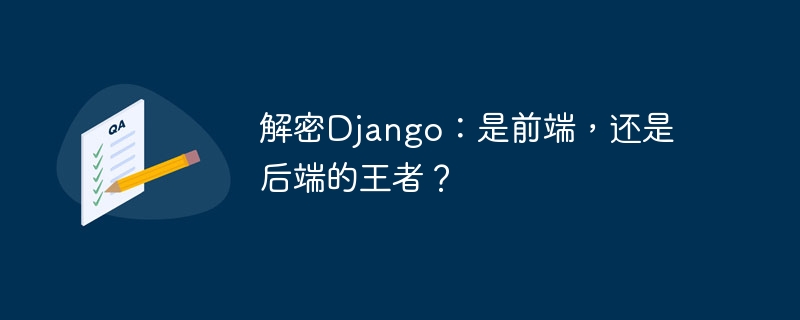

Django is a popular web framework that is highly scalable and flexible, and it excels at developing large-scale web applications. However, for beginners, it can be difficult to figure out whether Django belongs to front-end or back-end development. This article will explain in detail where Django is and how to write front-end and back-end code in Django.
First of all, we need to clarify a concept: Django is a back-end web framework, which is mainly used to handle server-side logic. This means that Django is a server-side framework that handles data and requests, and it is often used with front-end frameworks such as React and Angular.
However, this does not mean that Django cannot handle front-end tasks. Django actually has many built-in templates and views that make it easy to generate HTML and CSS for rendering pages server-side. Such code can be regarded as part of the front-end code.
The following is a simple code example to illustrate Django's front-end and back-end functions.
In Django, we create a view function that will return an HTML page. In this page, we can use the Django template language to render dynamic content. The template language is very similar to HTML, but Python code can be embedded in it.
from django.shortcuts import render
def home(request):
context = {"name": "John"}
return render(request, "home.html", context)In the above code, we define a view function named "home", in which we pass "John" as a context variable into the HTML template. This variable is used in HTML templates. This is the content of our "home.html" template file:
<html>
<head>
<title>Django homepage</title>
</head>
<body>
<h1>Welcome {{ name }}</h1>
</body>
</html>In this template file, we use the Django templating language to insert variables from the context into the HTML. In the template, we use two curly braces to enclose the variable name. When we run this code, we will see the title "Welcome John" at the top of the page.
This simple example shows that Django can be used as a tool for front-end development. We can use Django to generate dynamic HTML and then send it to the client browser. However, this is not the main feature of Django.
In a real web application, we will use Django to handle advanced server-side tasks such as form submission, user authentication, and database connections. For example, we can use Django to create a user registration form and then store it in the database:
from django.shortcuts import render, redirect
from django.contrib.auth.forms import UserCreationForm
def register(request):
if request.method == "POST":
form = UserCreationForm(request.POST)
if form.is_valid():
form.save()
return redirect("home")
else:
form = UserCreationForm()
context = {"form": form}
return render(request, "register.html", context)In this example, we create a view function called "register" that uses Django's " UserCreationForm" template to generate the registration form. When the user submits the form, we use "form.is_valid()" to validate the content of the form and if the form is valid, save it in the database and redirect the user to the homepage. Otherwise, we will display an error message to the user.
In this way, Django provides us with a simple and powerful way to handle complex back-end tasks. In actual web applications, we can handle back-end tasks by using Django, and then use the front-end framework Generate good visual effects to quickly develop web applications.
To summarize, although Django comes with built-in templates and views to handle front-end tasks, its main role is to handle server-side logic. Therefore, Django is geared more towards back-end development, used in conjunction with front-end frameworks such as Angular and React and JavaScript libraries such as jQuery. By using Django for back-end development, we can easily handle complex tasks such as user authentication, form submission, database connection, and business logic, and leverage front-end frameworks and libraries to provide users with a good user experience.
The above is the detailed content of Decrypting Django: Is it the king of front-end or back-end?. For more information, please follow other related articles on the PHP Chinese website!
 Is python front-end or back-end?
Is python front-end or back-end?
 How to implement instant messaging on the front end
How to implement instant messaging on the front end
 The difference between front-end and back-end
The difference between front-end and back-end
 Introduction to the main work content of the backend
Introduction to the main work content of the backend
 Introduction to the relationship between php and front-end
Introduction to the relationship between php and front-end
 What is the reason for DNS resolution failure?
What is the reason for DNS resolution failure?
 The difference between mysql and sql_server
The difference between mysql and sql_server
 pdf to xml format
pdf to xml format